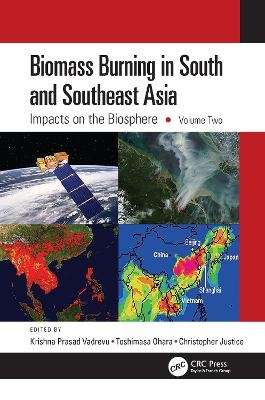
Biomass Burning in South and Southeast Asia
CRC Press (Verlag)
978-0-367-07604-7 (ISBN)
- Lieferbar (Termin unbekannt)
- Versandkostenfrei innerhalb Deutschlands
- Auch auf Rechnung
- Verfügbarkeit in der Filiale vor Ort prüfen
- Artikel merken
Biomass burning is one of the most important sources of greenhouse gas emissions and aerosols in South and Southeast Asia and greatly impacts other countries through transboundary air pollution. With contributions from leading scientists, this volume offers an interdisciplinary perspective on the impacts of biomass burning on the land resources, climate, and the atmosphere. It showcases several examples linking top-down remote sensing, bottom-up ground-based measurements, and an integrated modeling to address the impacts of biomass burning and land–atmosphere interactions. It is a valuable guide for readers in atmospheric science, ecology, spatial geography, remote sensing, and GIS.
This book is unique as it highlights the sources and the causes of biomass burning and atmospheric research in South and Southeast Asia.
It explains the latest tools and techniques, in particular the use of satellite remote sensing and geospatial technologies for fire mapping, monitoring, and land cover/land use change.
It focuses on large spatial scales integrating top-down and bottom-up methodologies.
It addresses the pressing issues of air pollution rampant in South and Southeast Asia.
It includes contributions from global experts working on biomass burning projects in the USA, Japan, South/Southeast Asia, and Europe.
The contents of this book will appeal to students and professionals using remote sensing and geospatial techniques, including geographers, ecologists, atmospheric and environmental scientists, and all who are interested in biomass burning pollution.
Krishna Prasad Vadrevu is a scientist at the NASA Marshall Space Flight Center, Huntsville, Alabama, USA. His current research is on remote sensing of land cover and land use change (LCLUC). He has 17 years of research experience and is interested in land-atmosphere interactions. He also serves as the lead scientist for NASA South/Southeast Research Initiative and coordinator for the NASA LCLUC program. Toshimasa Ohara is a scientist at National Institute of Environmental Studies, Tsukuba, Japan. He has 32 years of research experience in air quality modeling, emission inventories, and pollution research. He is a lead developer for Regional Emission Inventory in Asia (REAS) and currently interested in linking top-down and bottom- up approaches for emissions quantification. Christopher Justice is a full professor at the Department of Geographical Sciences, University of Maryland, College Park, USA. He has 38 years of research experience in remote sensing. His current research is on land cover and land use change, global fire, and global agricultural monitoring systems, all using remote sensing. He is the NASA LCLUC program scientist, member of MODIS science team, and global implementation lead for the GEO Global Agricultural Monitoring Task. He is also co-director for the center of Global Agricultural Monitoring and Research.
Section I Biomass Burning and Regional Air Quality Chapter 1 Impacts of Biomass and Garbage Burning on Air Quality in South/Southeast Asia Chapter 2 Biomass Burning and Their Impacts on Air Quality in Thailand Chapter 3 Impact of Biomass Burning on Local Air Quality in South China Chapter 4 Impact of Biomass Burning on Surface-Level Carbon Monoxide over Lahore and Karachi and Their Comparison with South Asian Megacities Section II Biomass Burning Emissions Chapter 5 Estimating Biomass Burning Emissions in South and Southeast Asia from 2001 to 2017 Based on Satellite Observations Chapter 6 Black Carbon Emissions from Biomass Burning in Southeast Asia ・ A Review Chapter 7 Satellite-Based Estimation of Global CO2 Emissions from Biomass Burning Chapter 8 Biomass Burning Mercury Emissions over the Maritime Continent Chapter 9 Biomass Burning Emissions in Indonesia and Policy Measures ・ An Overview Chapter 10 PM2.5 Emissions from Biomass Burning in South/Southeast Asia ・ Uncertainties and Trade-Offs Chapter 11 Greenhouse Gas and Particulate Matter Emissions from Rice Residue Burning in Punjab and Haryana States of India Section III Aerosol Pollution and Biomass Burning Chapter 12 Biomass Burning and Impacts on Aerosols: Optical Properties and Radiative Effects Chapter 13 Remotely Sensed Particulate Matter Estimation in Malaysia during the Biomass Burning Season in Southeast Asia Chapter 14 Impacts of Smoke Aerosols over Northern Peninsular Southeast Asia: Results from 7-SEAS Campaigns Chapter 15 Temporal Variation and Source Apportionment of PM2.5 Constituents in Phuket, Thailand Chapter 16 Impacts of Biomass Burning Aerosols on Air Quality and Convective Systems in Southeast Asia Chapter 17 Biomass Burning Influence on PM2.5 Regional and Long- Range Transport in Northeast Asia Chapter 18 Estimation of PM10 Concentrations from Biomass Burning and Anthropogenic Emissions Using the WRF・HYSPLIT Modeling System
| Erscheinungsdatum | 25.06.2021 |
|---|---|
| Zusatzinfo | 39 Tables, black and white; 29 Line drawings, color; 59 Halftones, color; 88 Illustrations, color |
| Verlagsort | London |
| Sprache | englisch |
| Maße | 156 x 234 mm |
| Gewicht | 620 g |
| Themenwelt | Naturwissenschaften ► Geowissenschaften ► Geografie / Kartografie |
| Naturwissenschaften ► Physik / Astronomie ► Angewandte Physik | |
| Technik ► Umwelttechnik / Biotechnologie | |
| ISBN-10 | 0-367-07604-7 / 0367076047 |
| ISBN-13 | 978-0-367-07604-7 / 9780367076047 |
| Zustand | Neuware |
| Informationen gemäß Produktsicherheitsverordnung (GPSR) | |
| Haben Sie eine Frage zum Produkt? |
aus dem Bereich


